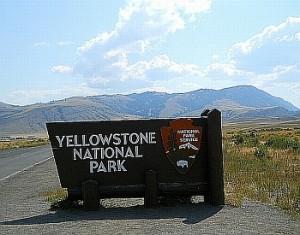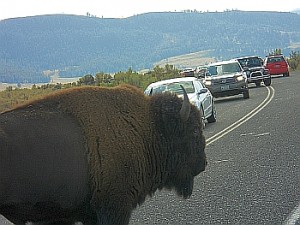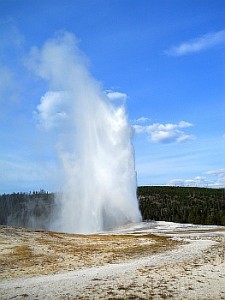Location is the most important factor when you’re looking to buy real estate. But when you’re looking to visit Yellowstone National Park, one of the most popular chunks of real estate on earth, timing is critical.
As the world’s oldest and most-loved national park, Yellowstone attracts millions of visitors every year. Yellowstone is a grand opportunity to see buffalo and grizzly bears living in the wild. The park is at the heart of the Old West, evoking images of early mountain man John Colter, who is believed to be the first white man to come to Yellowstone.
Coping with the crowds
Millions of visitors. Thousands of animals. All competing for the same space. What’s a person to do?
For starters, avoid visiting Yellowstone in July, which is the busiest month as upwards of 30,000 people a day visit. Since the park is spread out over 2.2 million acres, 30,000 people may not seem like a lot. Remember this when you’re standing in line to get an ice cream cone or use a restroom, are stuck in a traffic jam on the two-lane roads, or trying to see Old Faithful erupt when you’re standing behind crowds of people who are taller than you are.
If July is the only time you can take vacation, you can manage but you’ll need to do some advance planning:
- Try to avoid entering the park through West Yellowstone, Montana. Yellowstone has five entrances, with about a third of all visitors entering at West Yellowstone.

The Gardiner, Montana, entrance to Yellowstone - Make hotel and campground reservations early to ensure you have a place to sleep. Hotels and lodges start filling up in the fall months for the next summer; make a reservation as soon as dates are pinned down.
- Start your day early while other visitors are still sleeping.
- Pack a picnic lunch to eat at a pull-off so you don’t have to compete with the hungry hordes at restaurants and snack bars inside the park.
- Take a hike. Honest. Park officials say a good way to beat the crowds is to get out of the car and take a walk over some of the park’s 1,000 miles of trails. There are plenty of trails suitable for people in average physical condition — get recommendations at a park visitor center. You’ll leave the crowds behind in about 30 minutes on the trail.
Since Yellowstone is a popular year-’round destination, the above suggestions will come in handy most any time of the year.
Know before you go
What you want to see and do in Yellowstone is another important factor in timing your visit, and doesn’t have anything to do with the number of visitors.
If you like snow, the winter months are a good time to visit when the park gets less than 20,000 visitors a month. Plan on using snowmobiles, snow coaches, cross-country skis or snowshoes to get around. Only the north and northeast entrances are open to wheeled vehicles during the winter months. Practically, though, the north entrance at Gardiner, Montana is the only one open to visitors during this time. The northeast entrance just south of Cooke City, Montana is open, but only to allow its residents an outlet, as the scenic Beartooth Highway closes for the winter about 60 miles north of town.
Animals are a big draw at Yellowstone. If you want to see baby animals, come in the spring. That’s also a good time to see grizzly bears after they emerge from hibernation and before they head to higher elevations to spend the summer.
Do remember to keep your distance from wild animals; though most are used to humans, it doesn’t mean they won’t turn on you. The park service requires you to keep 75 feet away from elk, buffalo and other animals, and at least 300 feet away from bears and wolves. If you question the reason for this, watch the video at visitor centers that shows elk attacking cars and buffalo tossing people around like pizza dough.
Don’t rush your visit
Yellowstone is a park to be savored, not rushed through in a day. Plan on spending a minimum of two to three days inside the park. You’ll need that long just to see the highlights. Yellowstone has two loop roads through the park. While it’s possible to drive both on a very long day, it’s not advisable. You’ll spend all of your time in the car and none of it at the remarkable geothermal sites. The maximum speed limit within the park is 45 miles per hour; in many places, it is 25 mph or 30 mph, and there are places where you’ll be lucky to go that fast. Both loops can be driven in a day each, though the southern one would be better split in two, giving you time to walk through the geothermal areas as well as make side trips to the Grand Canyon of the Yellowstone.

Animals rule the roads at Yellowstone. “Buffalo” jams are common occurrences. That’s where a buffalo, marching to his own drummer, leads a procession of cars, all moving at his pace, down the road. It’s not unusual to see dozens of cars, even a hundred or more, following behind the shaggy beast. Plus, traffic comes to a complete stop when animals are just off the highway as cars park on and alongside the road, even when there are very narrow shoulders, making it impossible to get through.
Finally, expect to find crowds anytime at Old Faithful, the most famous geyser in the world, as 80 percent of park visitors watch it go off. The estimated time of the next eruption is posted in the visitor center lobby, but the actual eruption time depends on the geyser itself. The park service provides bleachers that only hold 2,000 people, so you’ll need to get there early for a good seat.
Enjoy your trip!


